1lumen selects and reviews products personally. We may earn affiliate commissions through our links, which help support our testing.
LUMINTOP X9L review
Table of contents
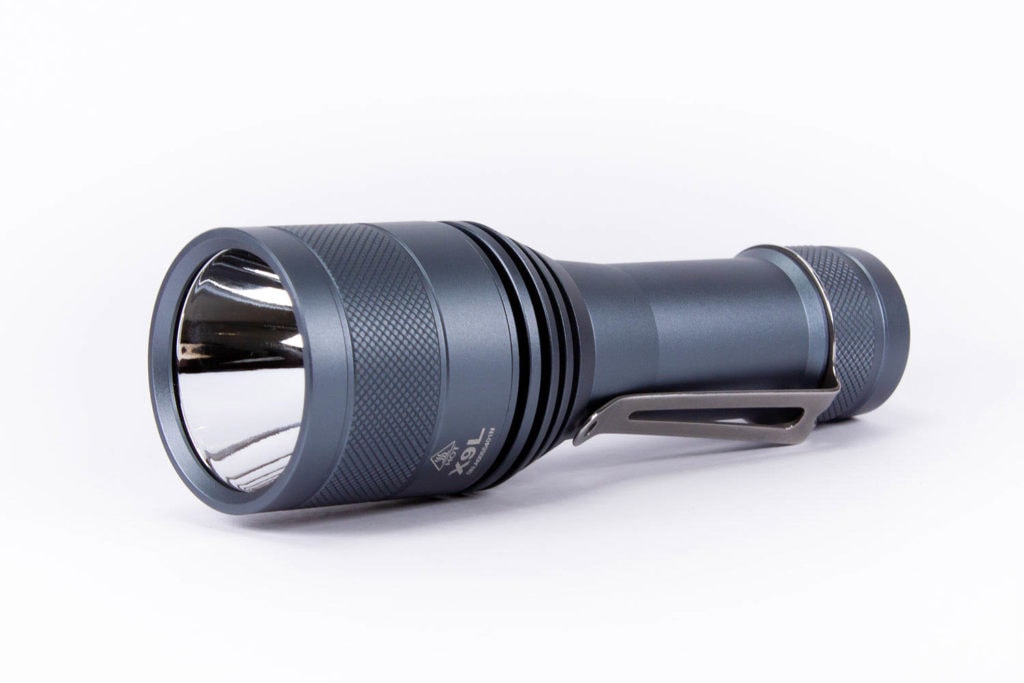
Specifications
| Brand/model | LUMINTOP X9L |
|---|---|
| LED | Luminus SBT90.2 |
| Lumens | 6,500 lm |
| Beam intensity | 163,800 cd (810 meters) |
| Battery config. | 1*21700 |
| Material | Aluminum |
| Modes | Lots! |
| Blinkies | Lots! |
| Reflector | Smooth |
| Waterproof | IPX8 |
| Review date | December 2020 |
INTRODUCTION:
The Lumintop FW21 X9L is the latest in what I affectionately like to call “the ongoing FW saga” – as there are just so many iterations of the FW3A now, it’s become quite difficult to keep track. I’m still attempting to compile a full list of the releases of this series, but I’m waiting for some more details on release dates to get it all chronological. I’m now up to over 20 iterations, so it’s definitely quite a list!
I may make jokes about the FWxx, but this is one, in particular, I’ve been waiting for. Putting the SBT90.2 into a small body seems patently ridiculous, but I happen to have a soft spot for ridiculous lights. I’m very excited to put this light through its paces.
I’m going to primarily refer to the light as the X9L from here on out, as “FW21 X9L” doesn’t roll off the tongue fingers that easily.
Package quality.
As with most of the larger Lumintop lights, the X9L comes in a neutral cardboard box emblazoned with the Lumintop logo (or, what is now the old logo), covered by a sleeve with a line drawing of the light itself, giving you a nice representation of the light within.
Inside the box, the X9L is nestled securely, with accessories. The contents of the box are:
- The X9L itself
- An 18650 to 21700 adapter
- A rubber grip-wring
- Two o-rings
- User manual
- Instructions for correct alignment of the battery
Interestingly enough, this appears to be from an FW3A – it references using an 18650, and has the narrow head as per an FW3A. Perhaps it’s just because I’m so used to the cell direction, but this doesn’t bother me at all. It still shows the correct alignment, even if it does reference a different cell size.
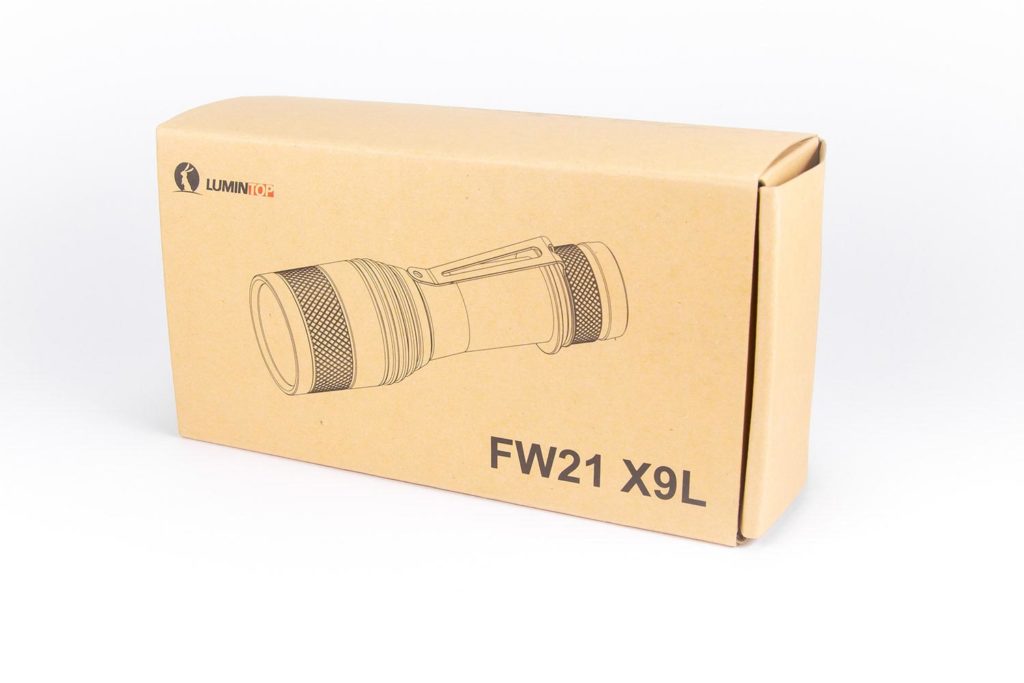
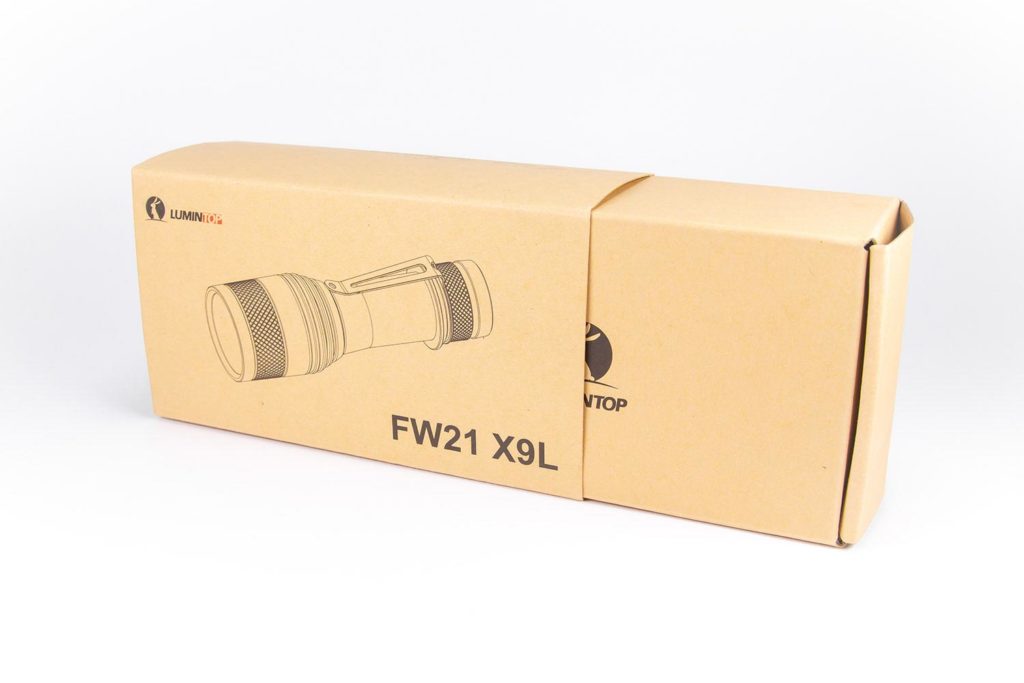
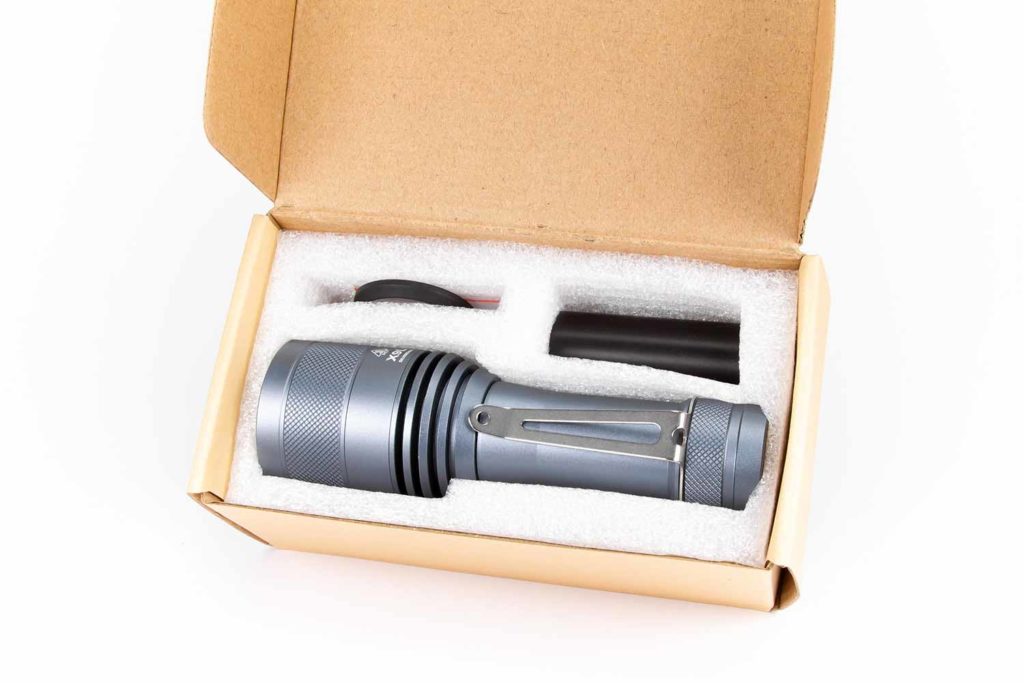
Handling of the light
The X9L feels very nice in the hand – there’s no sharp edges anywhere that I can detect. It’s primarily smooth, bar the heat-sinking fins at the head, which I’ll come back to soon.
There’s an e-switch at the tail which has a nice solid click feeling. It’s more pronounced than the switch I’ve previously encountered in the FW3A. I can activate it with my thumb at the sides as well as in the middle, which is nice – previous switches had issues with that. As with other lights in the FWxx series, the e-switch is flush with the tail itself, or very slightly inside. This makes it fairly important to lock the light out when carrying it in a bag or pocket. It also has the now-old Lumintop logo on it, which is new for me!
The size of the X9L lends itself to being carried in a holster or small bag; as the head is ~40mm wide, it’s definitely uncomfortable to have in a pocket against your leg, unless it’s in a cargo pocket or similar.
The pocket clip included is the same design as the other FWxx lights; a captive ring around the body tube, held in place by the tailcap, straight out from the body and then down towards the head. It fits well on belts and other things of that ilk. Normally I’d prefer the deep carry clip as on my FW3As, but this isn’t really that kind of light.
Included is a rubber grip, which is included for more “tactical” holding of the light. I’m not really a fan of this though, as it’s an absolute pain to get on, even if you remove the tailcap. Given that most of the issues with the FW3A lights was to do with the tailcap being removed, I personally don’t recommend its use.
Tail-standing is possible, albeit somewhat unsteadily. This is due to the X9L being top-heavy based on the shape of it. You can also purchase a diffuser for the light that helps turn this into a lantern; that said, it’s definitely made more for the FW21 Pro, as the emitters in that light are more floody, and better suited for being diffused.
Note regarding the images – if you hold it in turbo with your thumb on the fins like in the images, you will be enjoying some freshly toasted thumbprints.
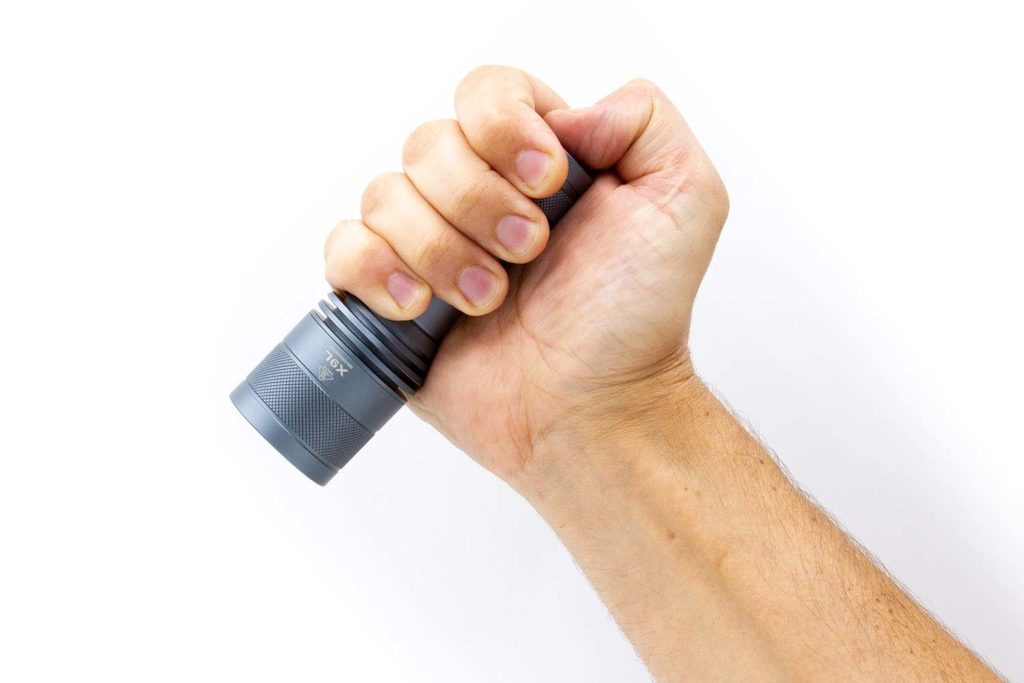
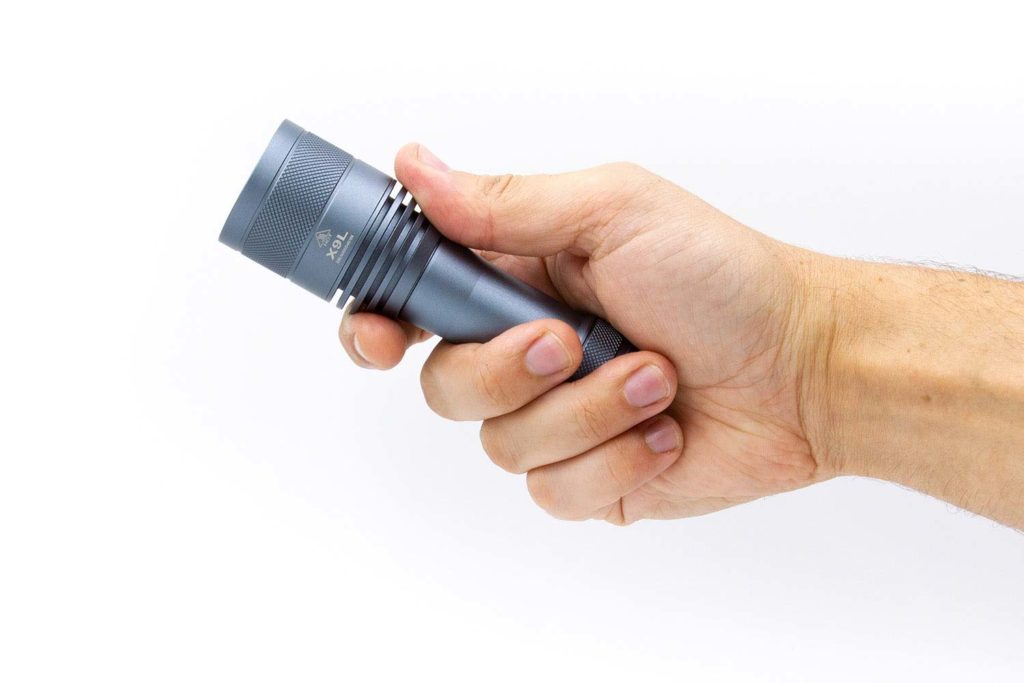
Build Quality, Knurling, Threads, and anodization
The X9L I’m reviewing is the Aluminium version, which is essentially a grown-up FW3A. There’s a few noticeable differences, much to my delight – the signal tube which caused so much trouble originally has grown in width, especially on the tailcap end, so there’s great contact now. The driver is also a little larger, so things are less squished, but that’s purely due to the increased size of the light.
One of my favourite inclusions is that the e-switch cap has the Lumintop bunny on it – sadly that has now been discontinued due to legal action. It’s a nice bit of extra texture on the button, and a great reminder of what was. I’m sure that future revisions missing the bunny will just feel a touch incomplete.
The knurling on this light is on both the tail and head; the tail knurling is interesting in that all the documentation described removing the head to change the cell, and it’s common knowledge through the community not to remove the tailcap on an FWxx light, due to the switch construction – in early models, things were not held in with a retention ring.
That said, the knurling is quite smooth, and is more aesthetic than functional. There is plenty of room on the head to hold while removing it to swap the battery.
There’s no faults in the anodisation anywhere I can see, and it’s smooth with the very lightest touch of texture – all in all, quite pleasant to hold. There’s no sharp edges anywhere I’ve found – the heat sinking fins appear somewhat aggressive, but are smooth when running a finger over them.
Threads in the light are rectangle-cut, and very smooth. As always, a quick re-application of lubricating grease doesn’t go astray, although what’s already there is perfectly sufficient.
The tactical grip ring and 18650-21700 adapter are well made, but I don’t recommend either, which I’ve mentioned (rubber grip) and I’ll go into soon (adapter).
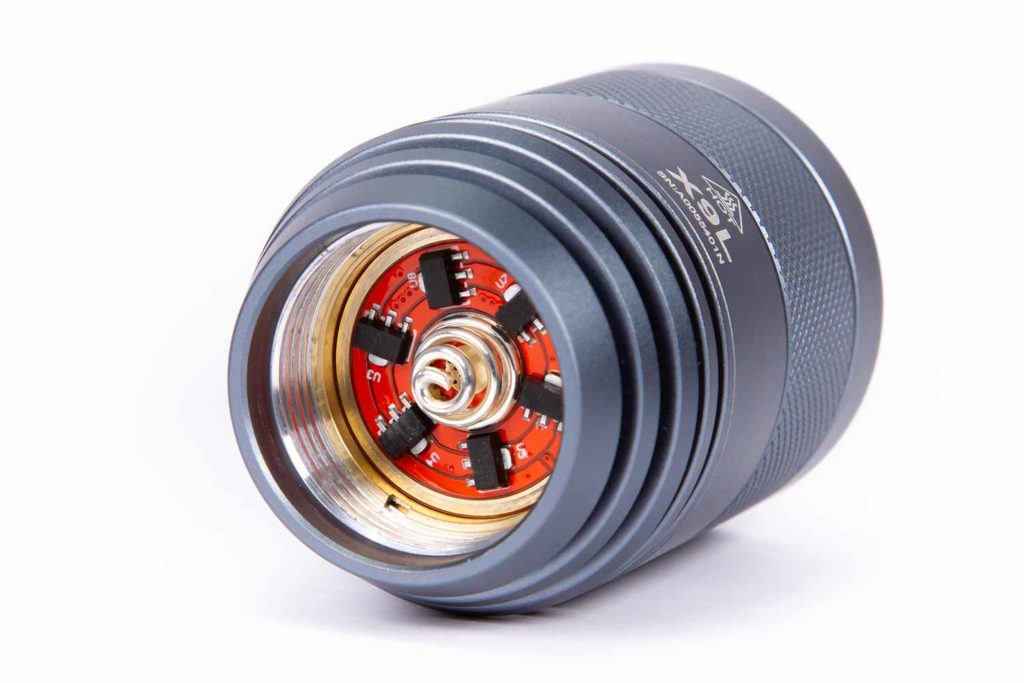
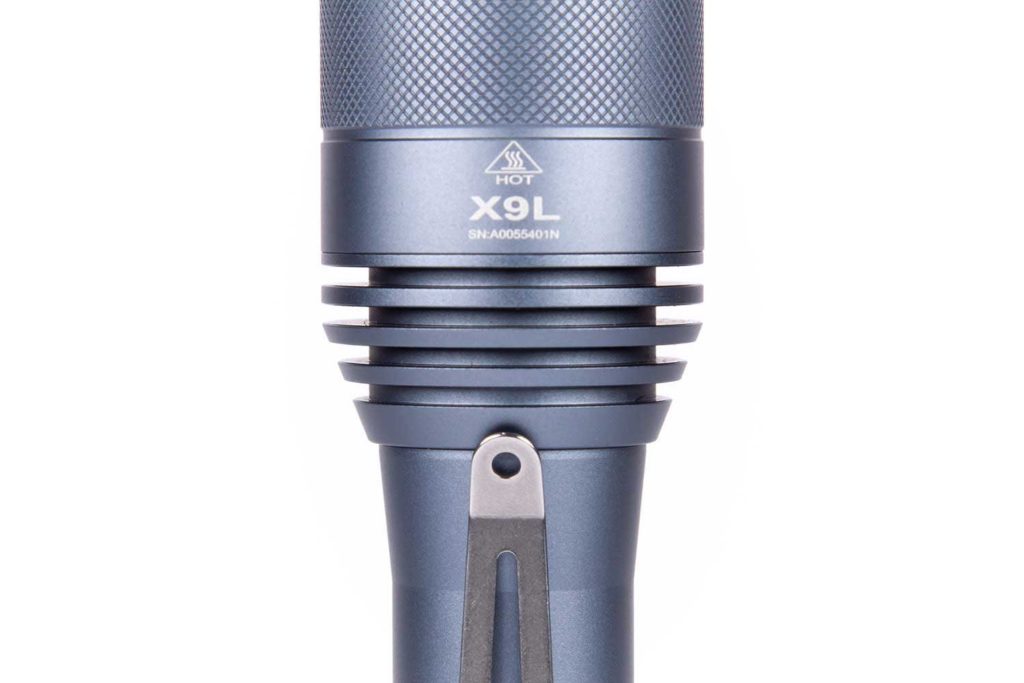
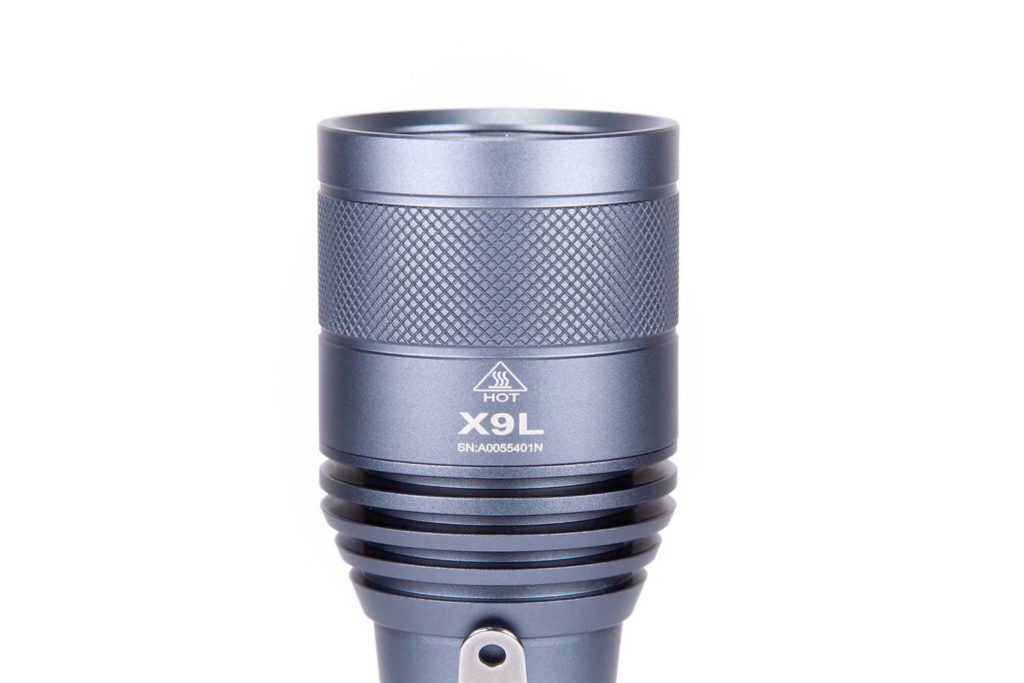
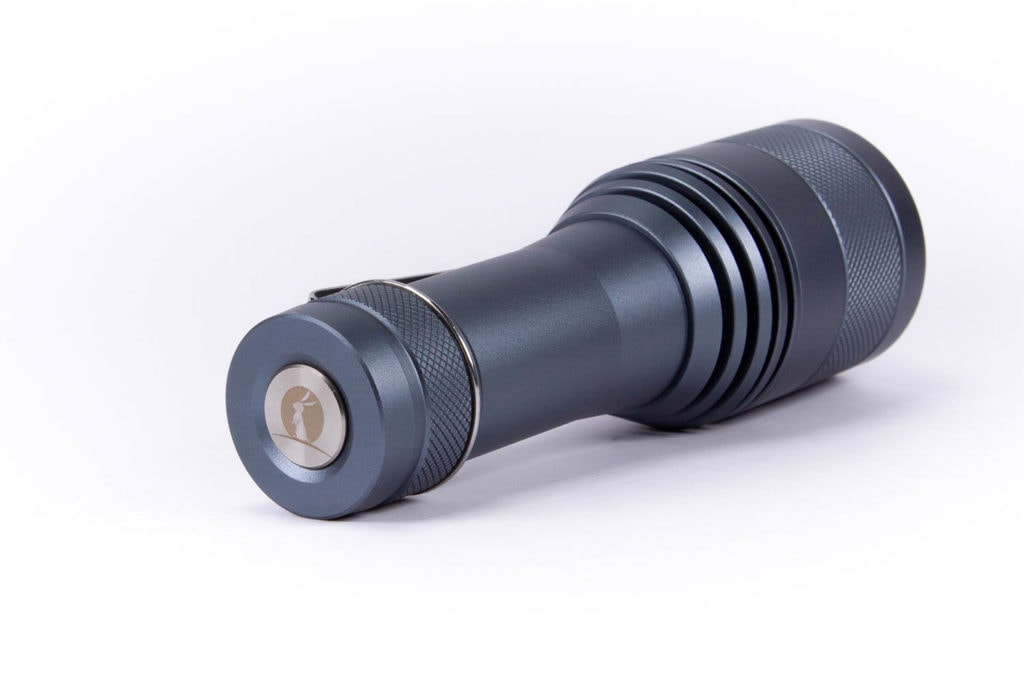
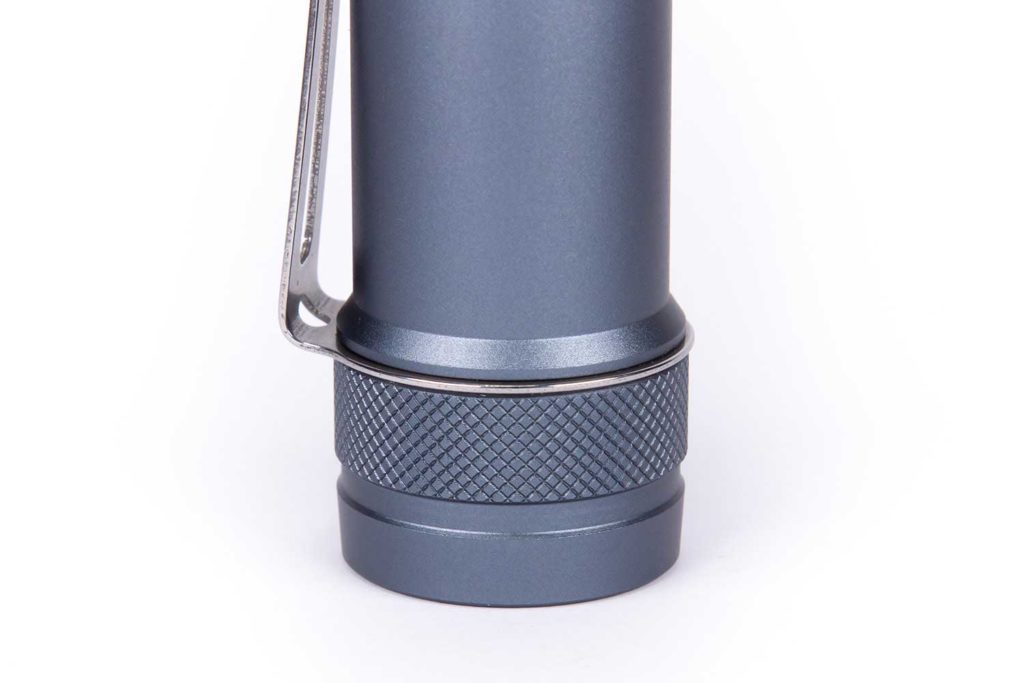
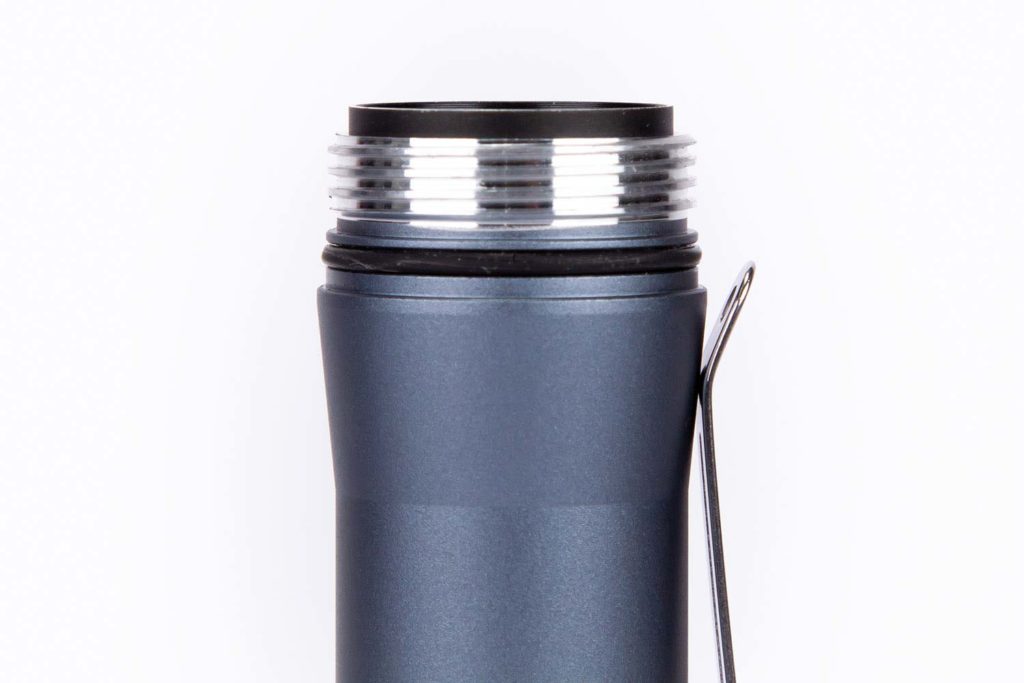
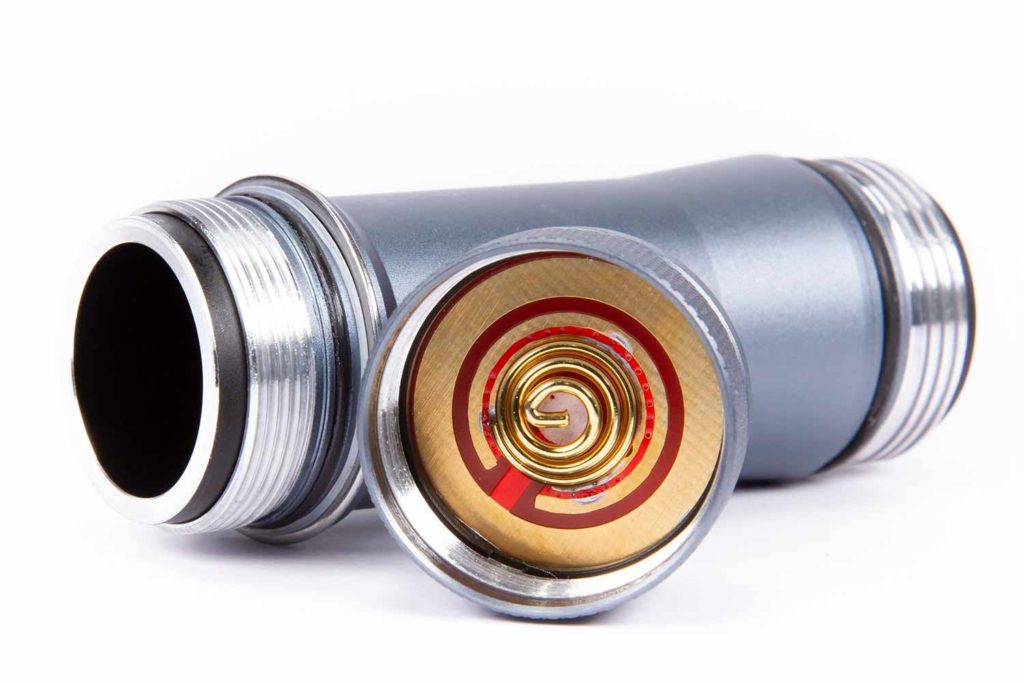
LED, LENS, BEZEL, AND REFLECTOR
The drawcard of the X9L is definitely the emitter – the Luminus SBT90.2. This emitter is only available in cool/cold white; I believe this is at 5700K. It’s an emitter that’s built for a whole lot of light, both lumens, and throw, but is very power-hungry.
This is the emitter that is in the 1.85 mcd Lumintop GT90, which has 2.7km of throw. Nothing like that is expected though, purely due to the size of the reflector. It’s a solid pedigree, and can punch hard with the best of them.
The SBT90.2 is nestled behind a smooth reflector that’s fairly deep for a light of this size. This combination of LED and reflector helps give the light plenty of throw, which is the entire point of this light.
There’s no fancy bezel on the light, but that’s perfectly fine. As just mentioned, this light is meant to do a particular job – get a whole lot of light downrange in a small body.
The beam itself is a thick primary beam with a decent amount of spill. At low brightness, it has some green in the hotspot, but let’s be real – low brightness is not what this is designed for. This is designed for being on turbo, or at least very high.
The images I have of it in low modes appear more green than it does to my eye – in the interests of consistency of images though, I’ve opted not to edit them to match what my eye sees.
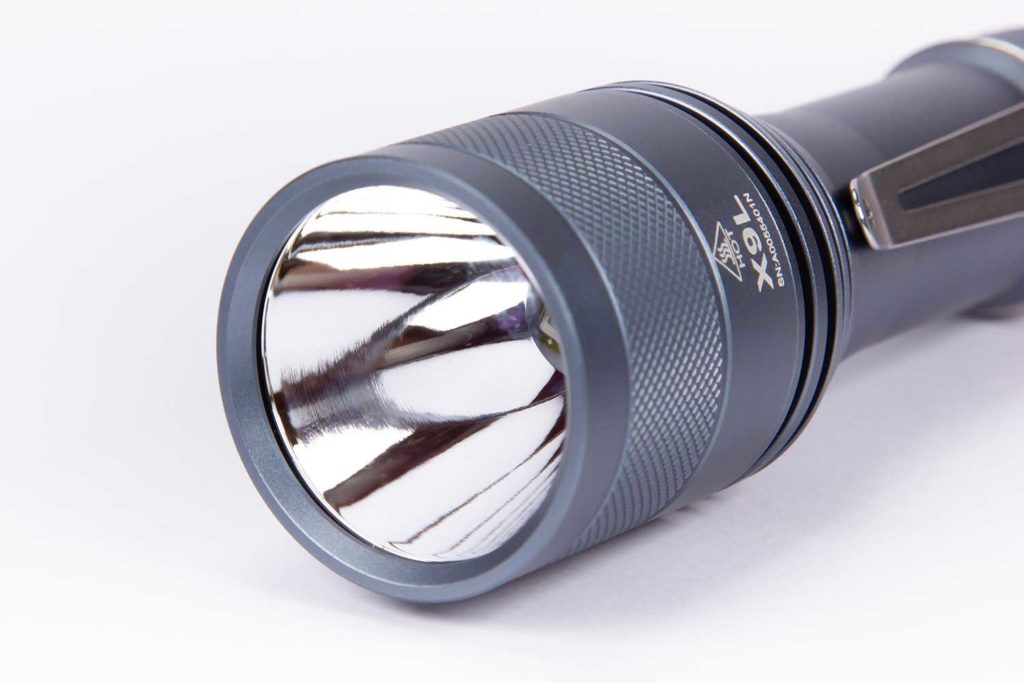
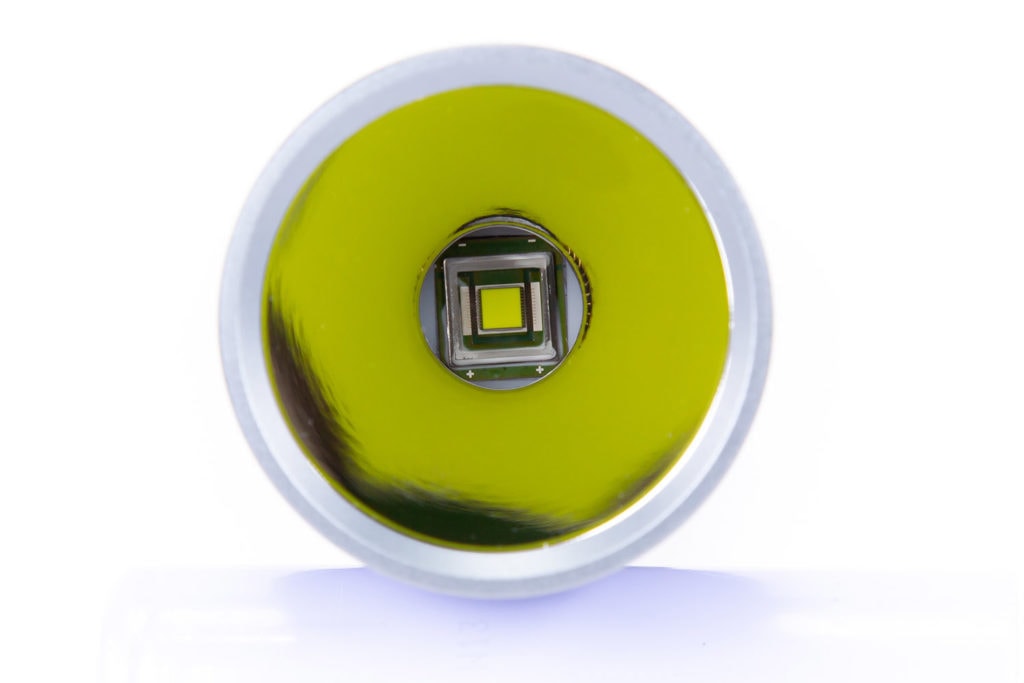
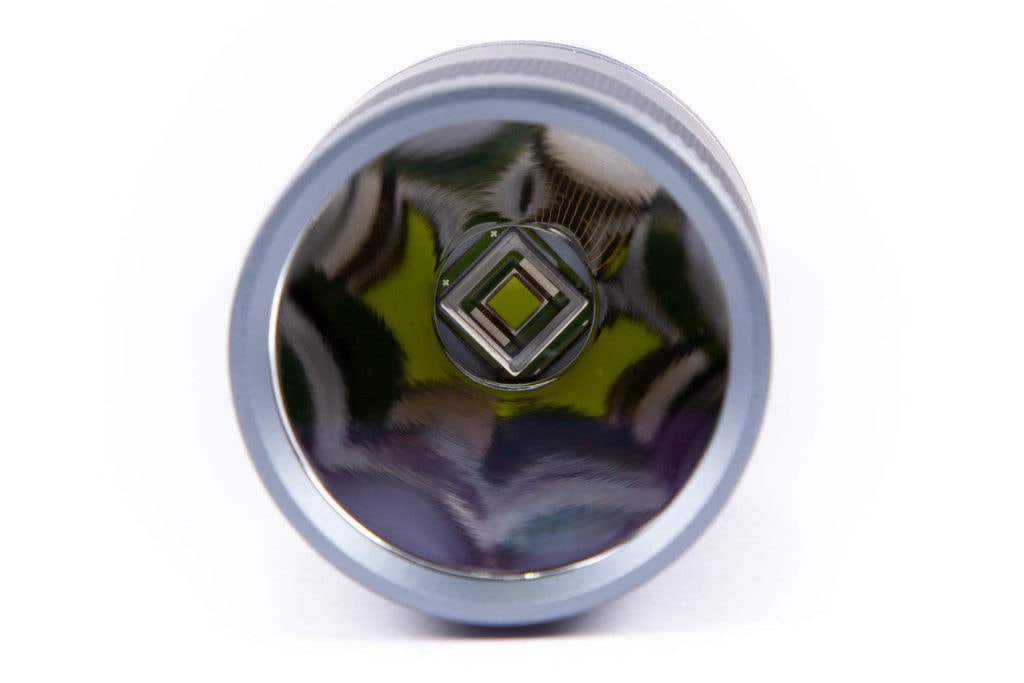
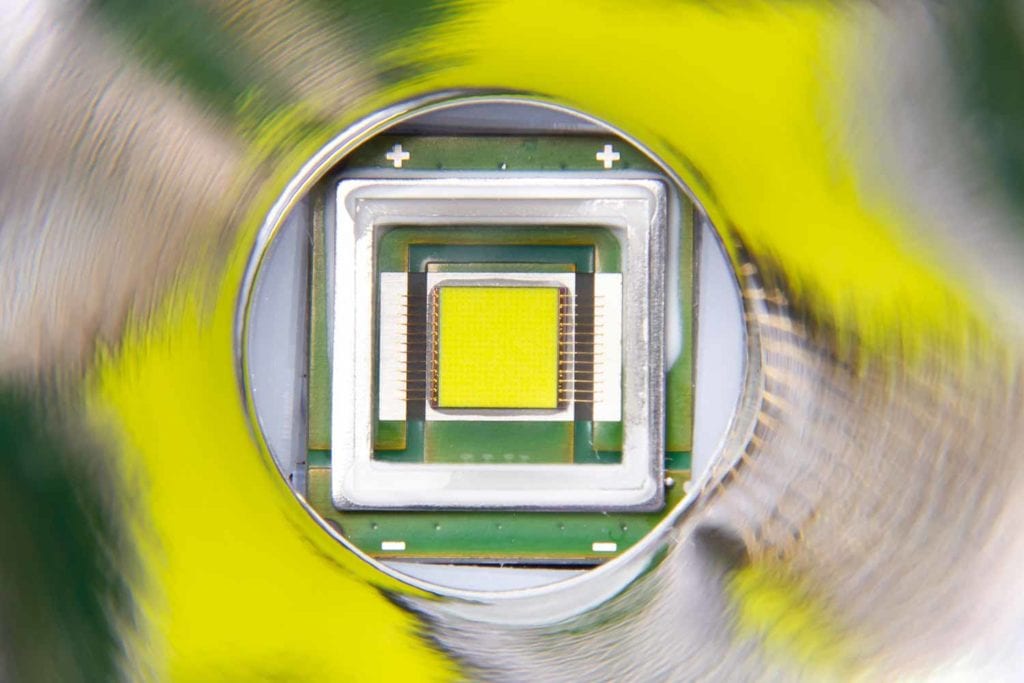
Dimensions
- Length: 123.5mm (4.86 in)
- Head diameter: 40.2mm (1.58 in)
- Body diameter: 25.4mm (1 in) at narrowest point
- Weight: 126.3g (4.46 oz)
- With Samsung 30T: 194.5g / 6.86oz
Popular Flashlights
Size compared to some of the best flashlights, big and small.
Image 1: Emisar D1, Lumintop X9L, Acebeam E10
Image 2: Lumintop X9L , Lumintop FW3A
Image 3: Lumintop BLF GT90, Lumintop X9L
Image 4: Lumintop GT Mini, Lumintop X9L, Astrolux FT03 mini
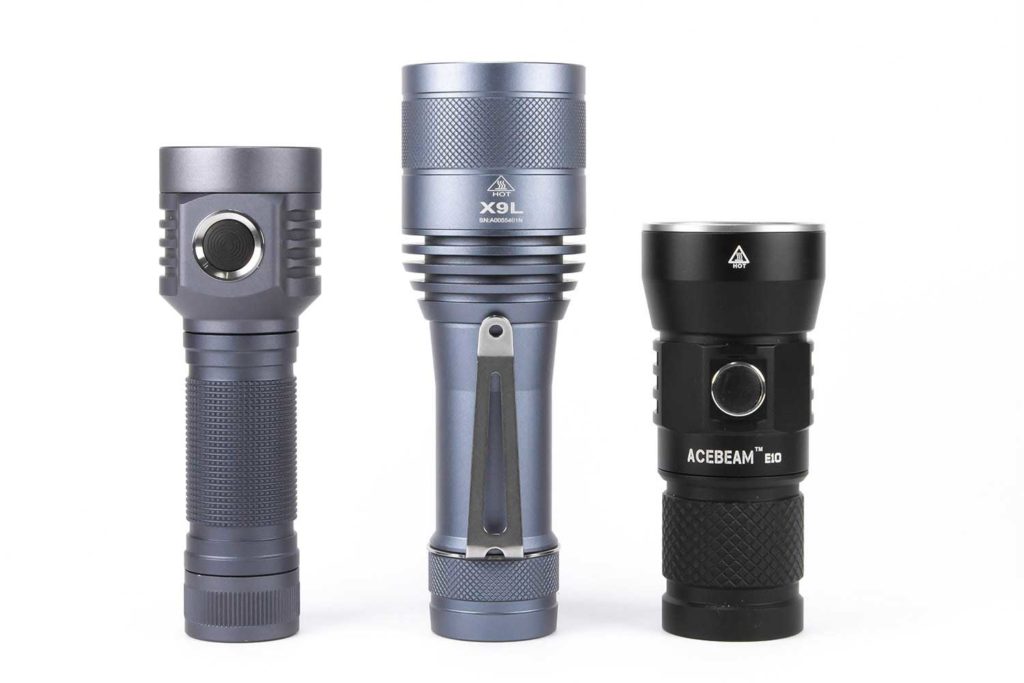
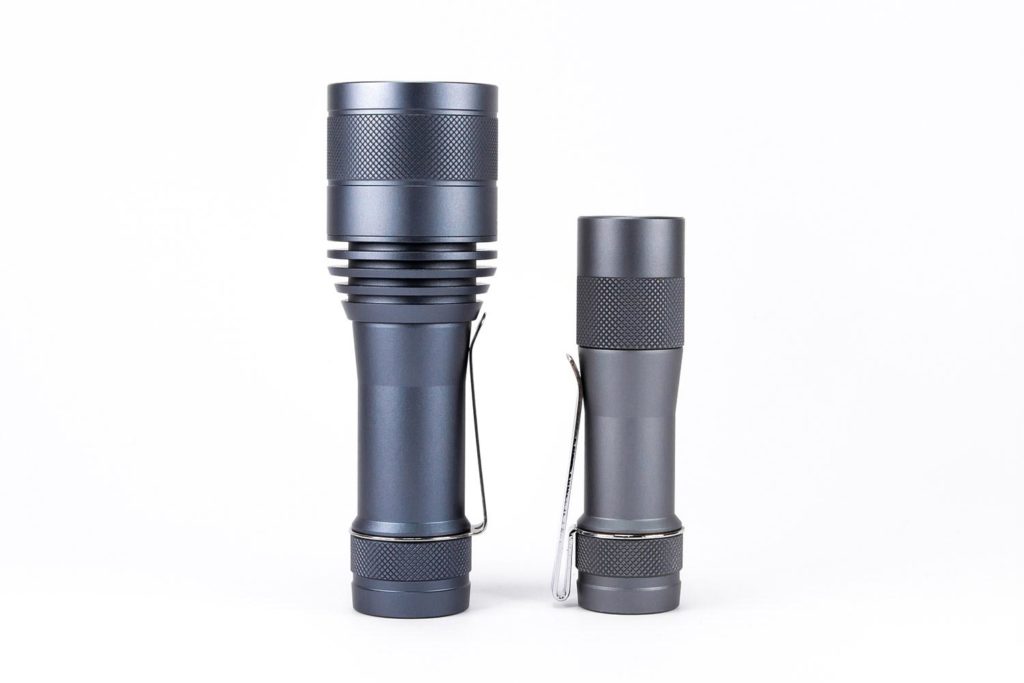
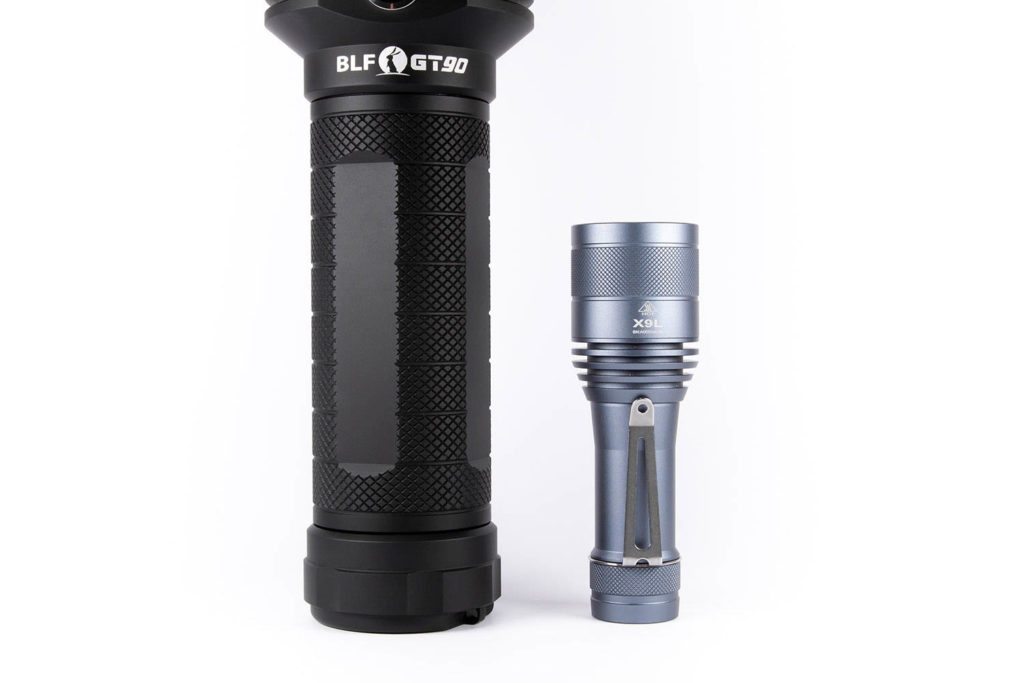
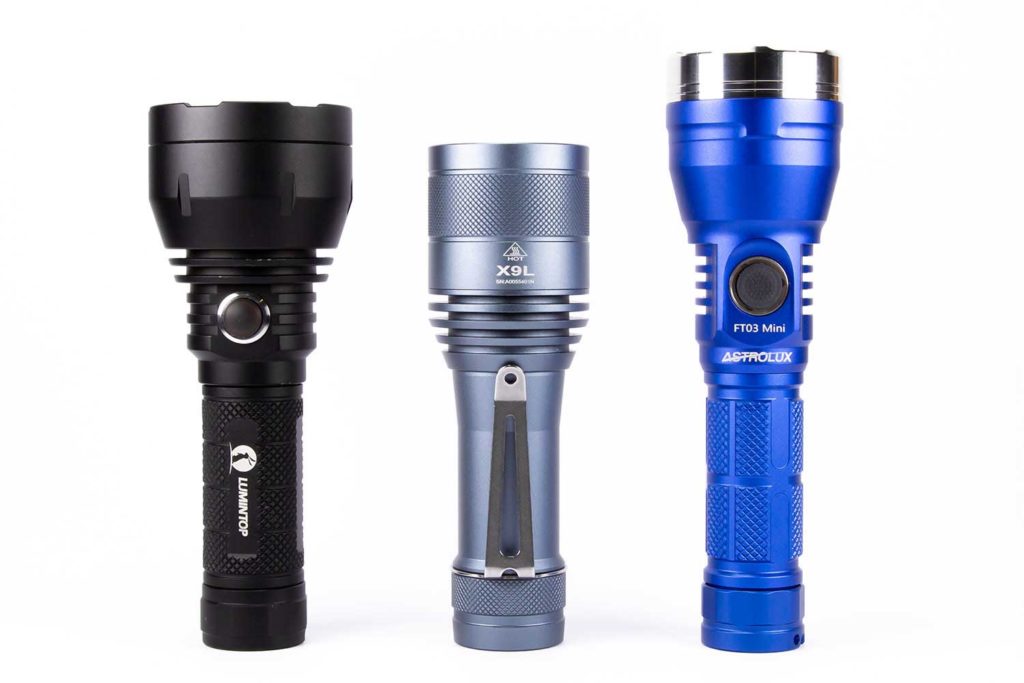
Driver & User Interface:
The X9L has a driver that’s effectively a larger FW3A driver – a FET+8. This comes with Anduril, which I’ve gone over a few times before, so please bear with the copy-and-paste! The version I have came with a firmware version that’s prior to v446 (2019-09-24), as it doesn’t have a version check on 15 clicks.
There’s a decent list of builds since then that have changes that affect this light (447, 451, 453, 464, 466, 470, 480, and 486) – but updates aren’t necessary to enjoy the light as it is.
Please note – thermal calibration is HIGHLY recommended! This can be done by first leaving your light somewhere near a thermometer for some time to settle to a known ambient temperature, then clicking three times from off, then two times, two more, two more, and then four times to enter thermal configuration mode. From there, you will get one flash and then a buzz – click the button the amount of times that corresponds to the ambient temperature in Celsius. Ignore the two-flashes-then-buzz, then you’re all set. A diagram of this is found at ToyKeeper’s repository, and I have uploaded a video of it here.
Modes:
An awful lot! Anduril is one of the more intuitive UIs I’ve used, while also being extremely customisable. The general gist of it is:
From OFF:
- Click – On (to mode memory).
- Hold click: On to bottom of ramp
- Double Click: On to top of ramp
From ON:
- Click – Off.
- Hold click: ramp (or step) upwards, quickly release and hold again to ramp (or step) downwards
- Double Click: Turbo
From there, it can get ridiculously complicated – a UI diagram is below, and you can read a text-based manual here.
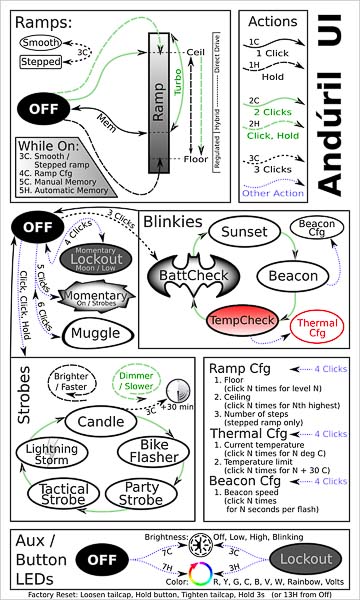
The driver board is an FET+8, which uses regulated modes below 350mA. The 8 7135 chips (the +8) helps keep output steady up to 2800m – going above that lets the FET take over and pull as much as it can out of the battery.
While I haven’t been able to fully test out LVP for this light, the brightness goes to almost nothing – I finished up my runtime charts after the light was running at almost nothing for some time; they all showed 2.96V. It would take quite a long time to kill a battery in this mode.
Strobe/blinkies
- There’s a fair few strobe modes – Bike mode, Tactical strobe, Party strobe (adjustable frequency), Candle mode, and Lightning mode. All good fun to play with!
Lock-out mode:
- As the general recommendation on this light is not to unscrew the tailcap, and the threads to the head are not anodised, the only real lockout on this light is to click four times from off to enter the software lockout. During this, you can hold the button to have momentary moonlight.
PWM
- There’s PWM visible by camera all the way from moonlight, but as I hit the top of ramp, it seems to disappear; I presume it’s fast enough at that stage to not be visible. Turbo is the same; no PWM visible (but then again, not much would be visible if you were looking straight at it while in turbo mode).
Batteries & Charging
The X9L is primarily a 21700 light and given the emitter in it, the more current you can throw at it, the better. The recommended cell is a Samsung 30T, with a maximum output of 35A continuous. It can run with other cells, but this brings its own compromises – using a 40T will increase the runtime, but at a cost of immediate output.
Included is an adapter to suit an 18650 to raise it to 21700 size, if you’re that way inclined, but the inherent limitations of an 18650 means I can’t recommend using it like this, unless you really need to see it working while waiting for a 21700 to ship to you (and I can totally understand that).
There’s no onboard charging, but that’s to be expected; the form-factor doesn’t give much room for anything like that.
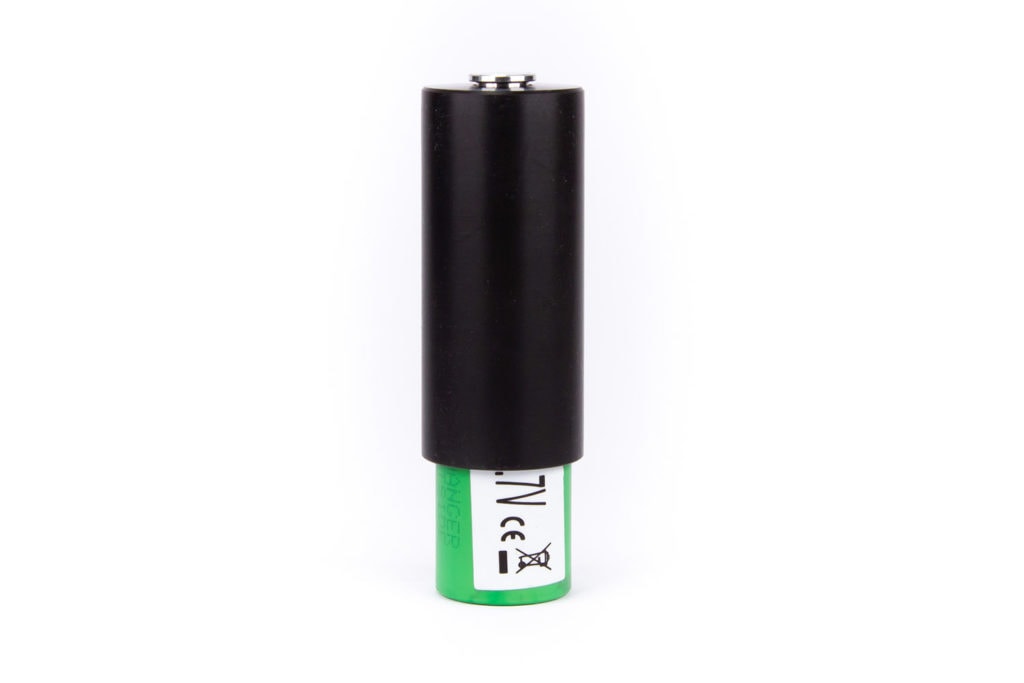
Performance
For my readings, I use the following:
Lux Meter: For lumen readings and runtimes, an Adafruit TSL2591 connected to a Raspberry Pi running Ubuntu, using RuTiTe by bmengineer in a custom sphere (build document coming soon, when I have some more time). A UNI-T UT383S is used for candela readings. An Adafruit MCP9808 rounds out the list for temperature monitoring.
DMM: UNI-T UT139C and UNI-T UT210E – 16AWG wire is used directly into the 139C via some banana plugs, and 8AWG wire in a loop for the UNI-T. The DMM I use depends on how high the expected current will be – I use the 139C for <10A, and the 210E for >10A.
I’ve tested output with the Samsung 30T; as mentioned above, it’s the ideal cell for the light if you want the most out of it.
Amp measurement
Given that Anduril is a smooth ramp, I’ll stick with just the top and bottom of the ramp, as well as a few modes in stepped (bottom, middle, top), and of course, Turbo. This should be the same between both ramps.
Ramped mode:
- Bottom of ramp: 2.2mA
- Top of ramp: 2.86A
Stepped mode
- Step 1: 19.8mA
- Step 4: 484mA
- Step 7: 2.86A
Turbo: 19.9A
While I’m a little upset that I couldn’t get 35A from this light with the 30T, perhaps it’s for the best – it heats up enough as it is with 20A, let alone throwing more into the mix. I happen to like my hands not being third-degree burned.
Runtime graph
From playing around with the light before I did runtimes, I kinda expected this. It heats up like crazy, and I could tell it was dimming quickly, so I would turn it down.
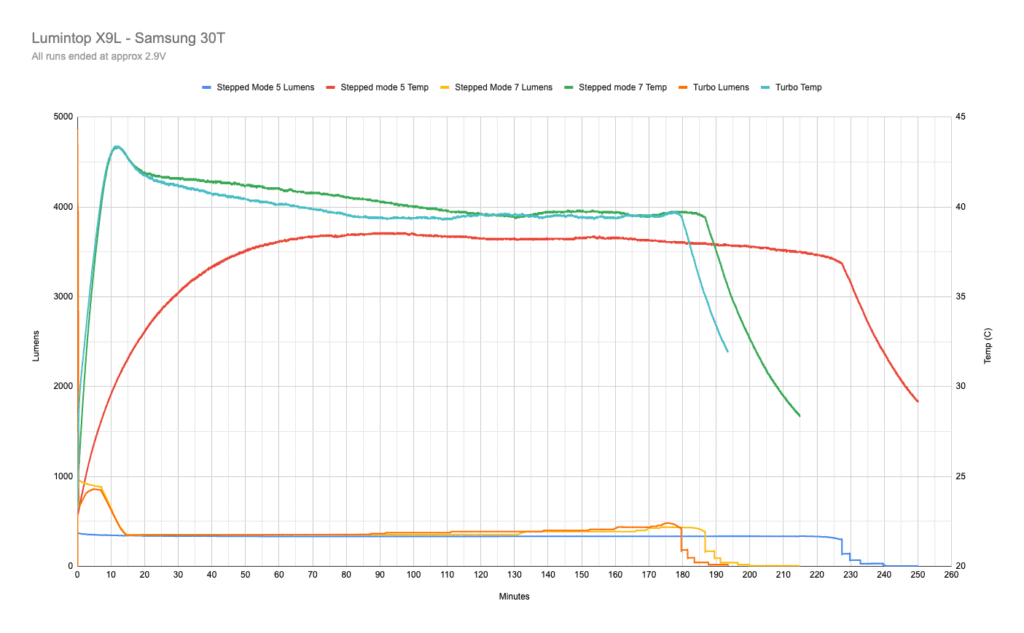
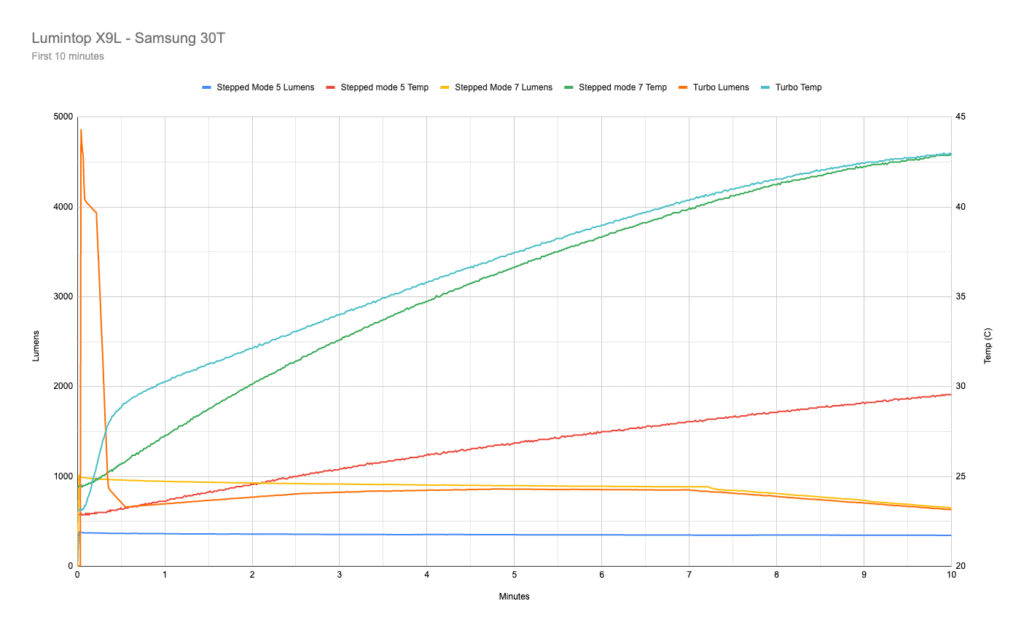
While I expected a decently quick dropoff, this one is big. Within 30 seconds we’re down to ~13% of the output it had at maximum. It just heats up so phenomenally quickly that it starts ramping down almost immediately, but thankfully there’s still a small period where you can show off the biggest pocket-light going.
After the big drop, it actually then goes on for another three hours at quite a low mode though, so there’s definitely some use to be had to it, but it’s down to a “I could have just brought a smaller light with me” kind of area.
Running in more regulated modes gives that same kind of low output that it ramps to, but just for longer. In stepped-mode 7, you get a bit longer “high power”, but it ends up coming down and cruising along too.
Definitely not a light for the long haul – just enjoy blasting it in turbo while it’s not thermally soaked.
Lumen measurements (for each mode)
Same as with current measurements, I’ll stick with some defined spots.
Ramped mode:
- Bottom of ramp: 1 lm
- Top of ramp: 872 lm
Stepped mode
- Step 1: 3 lm
- Step 4: 164 lm
- Step 7: 872 lm
Turbo: 4812 lm
Decently less than advertised, but all in all, I’m not upset about this. I don’t think I ever expected 6500 lumens when the GT90 is rated at 7000, and the candela more than makes up for it.
Throw numbers:
- 5m indoors: 6287 lux = 157175cd = 792.91m throw
- 10m outdoors: 1580 lux = 158000cd = 794.98m throw
Again, very consistent results. I must be doing something right! Slightly below the rated, but not by much – the rated throw is 809.44m, so we’re talking less than 20m, out at the 800m range.
Beamshots
Beamshots:
- Outdoor shot – tree is approximately 190m away.
- Indoor – all shots taken at ¼ sec, f20, ISO200, 5000K WB
- X9L vs Emisar D1
- X9L vs Astrolux FT03 Mini
- X9L vs AceBeam E10
Light comparisons:
- Lumintop GT90, Lumintop X9L
- Lumintop GT Mini, Lumintop X9L, Astrolux FT03 Mini
- Emisar D1, Lumintop X9L, AceBeam E10
- Lumintop X9L, Lumintop FW3A (where it all began!)
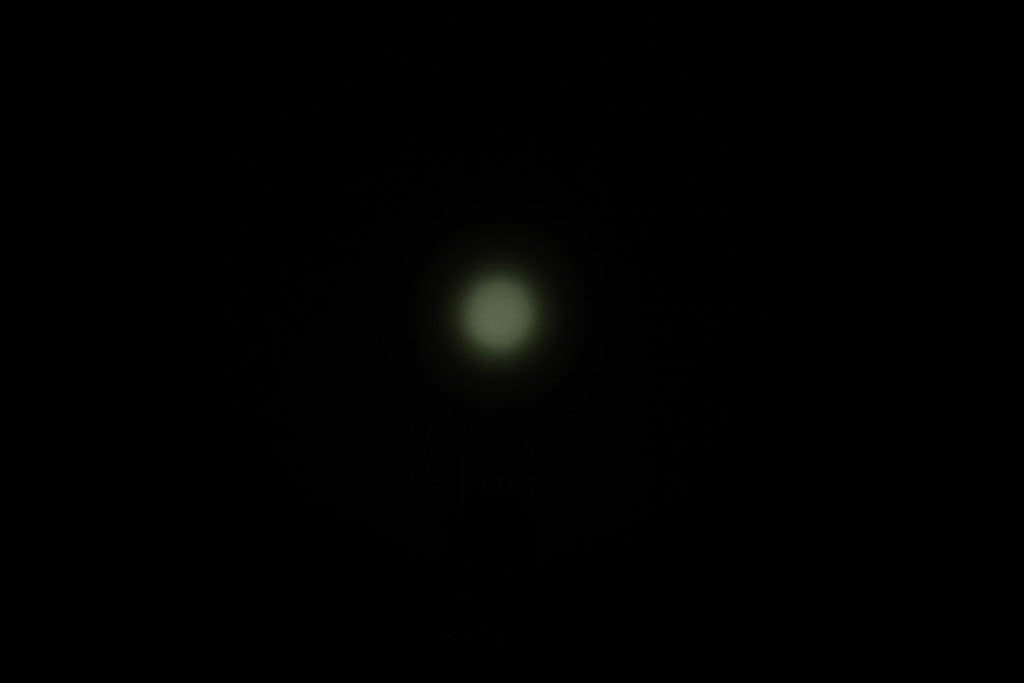
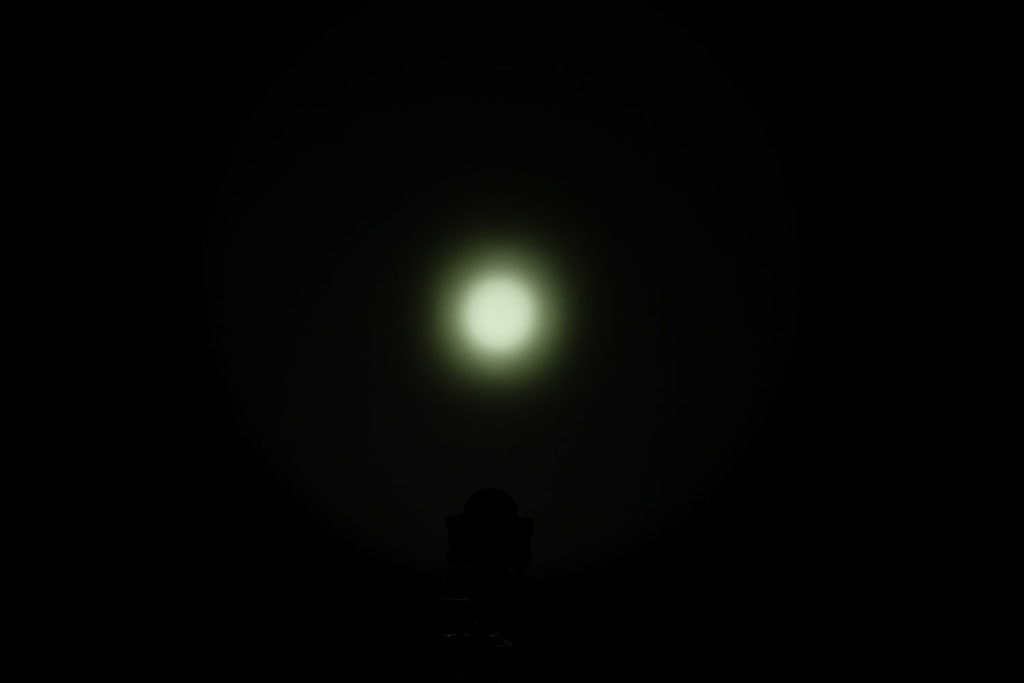
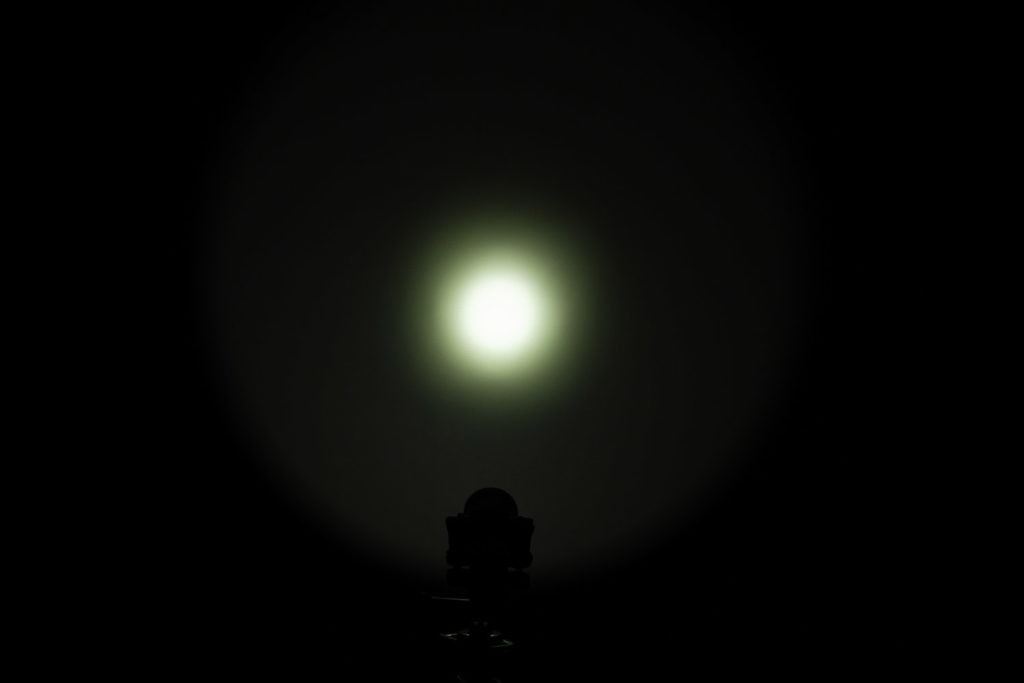
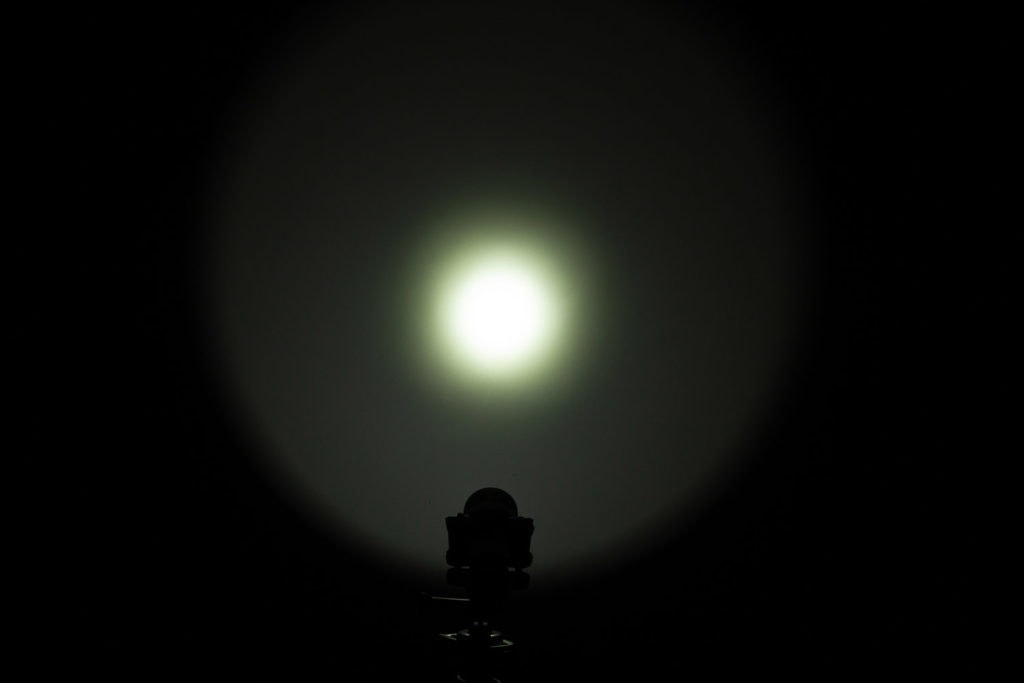
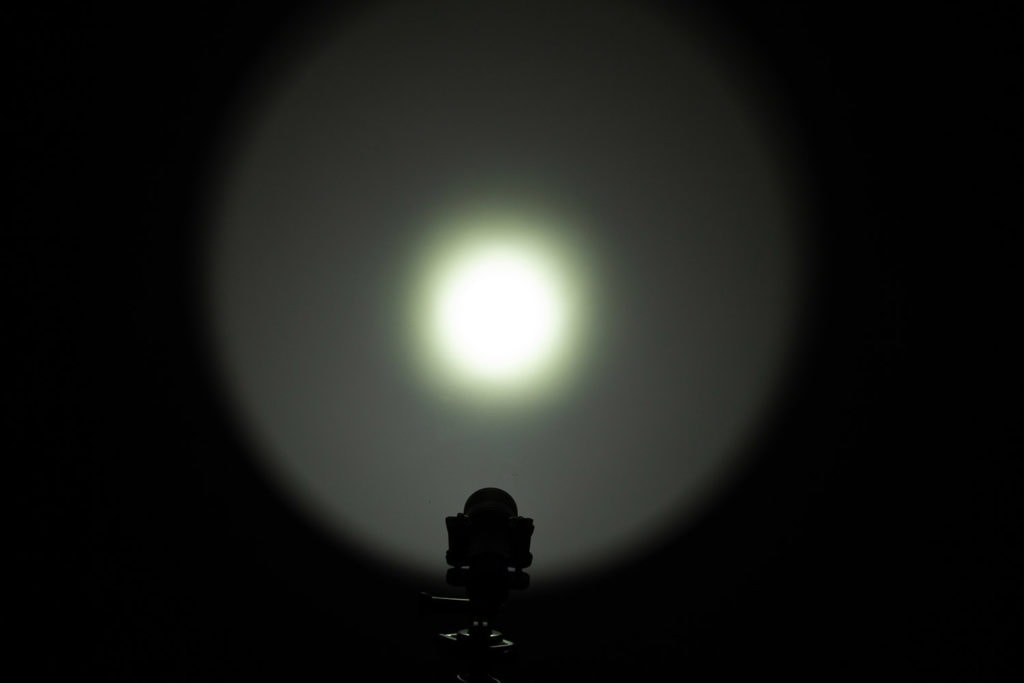
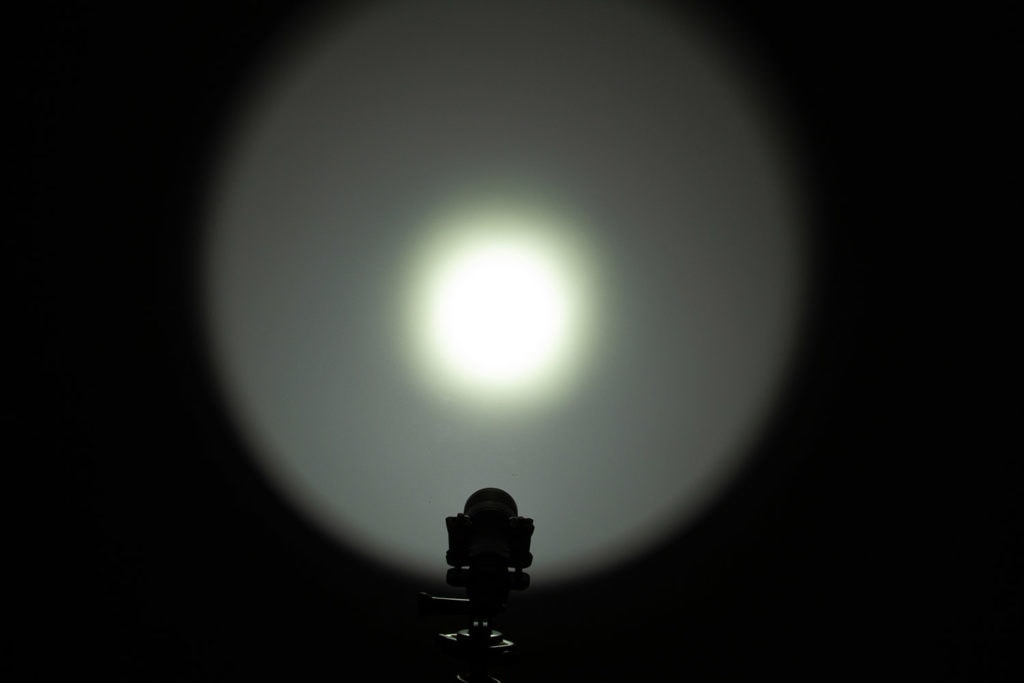
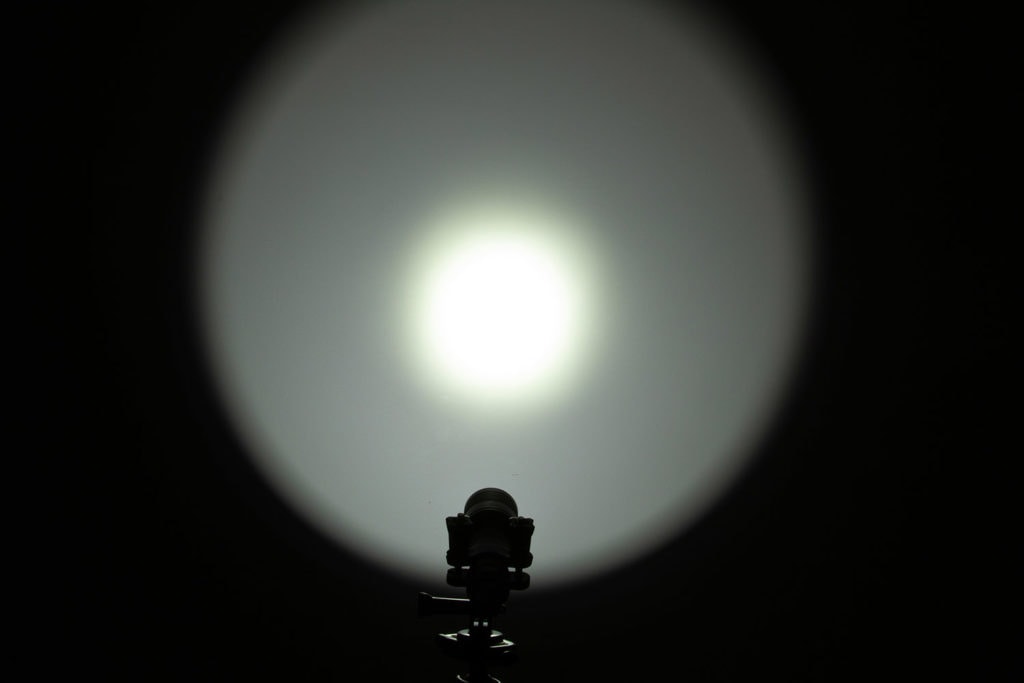
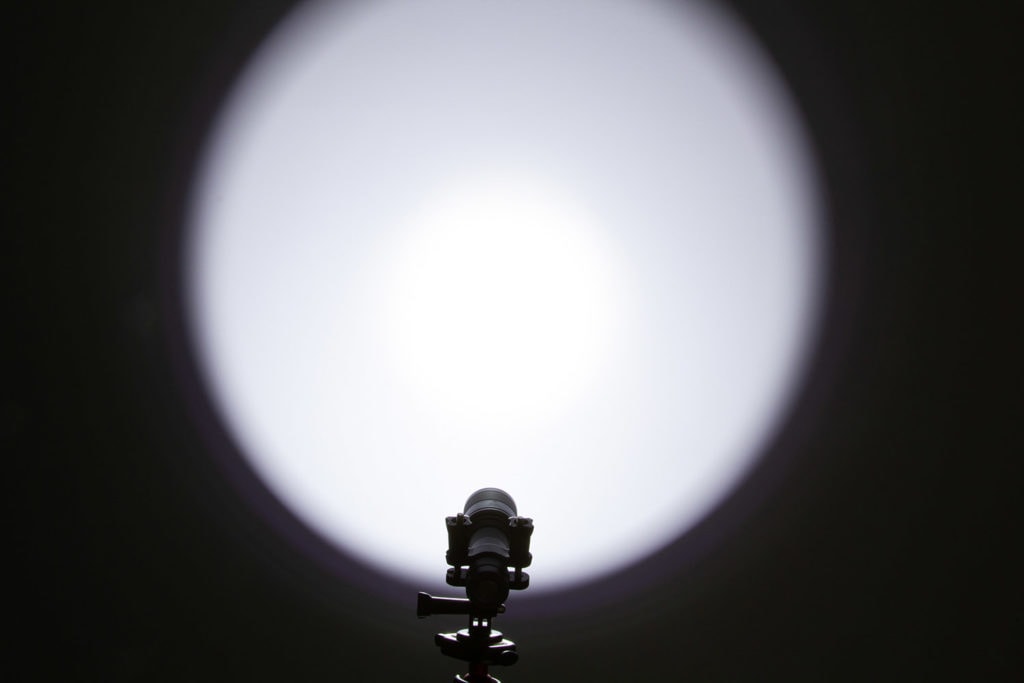
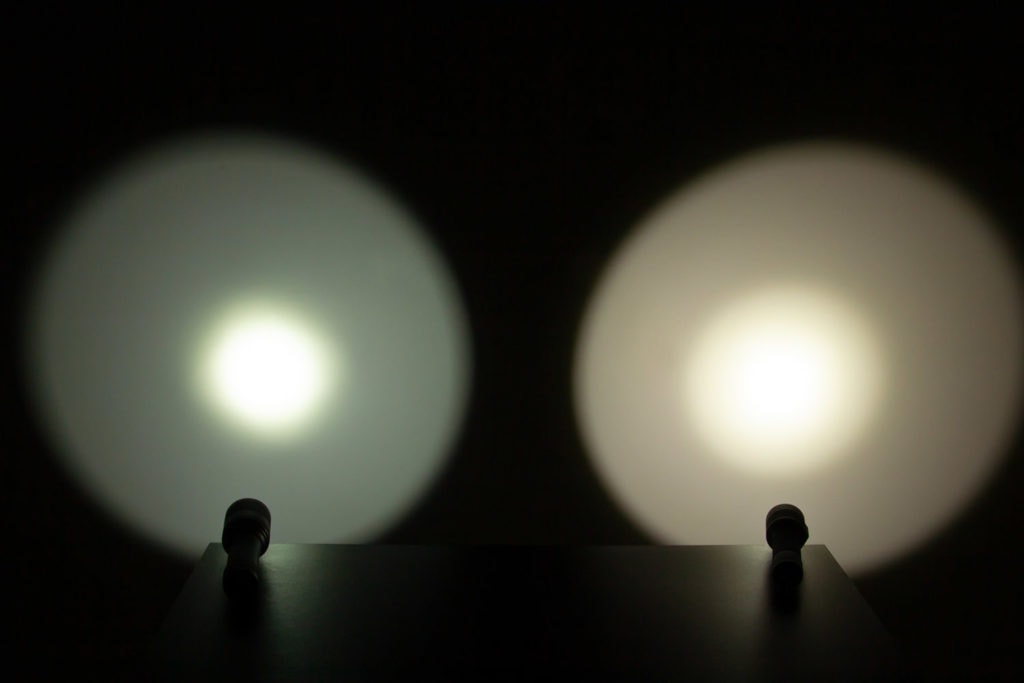
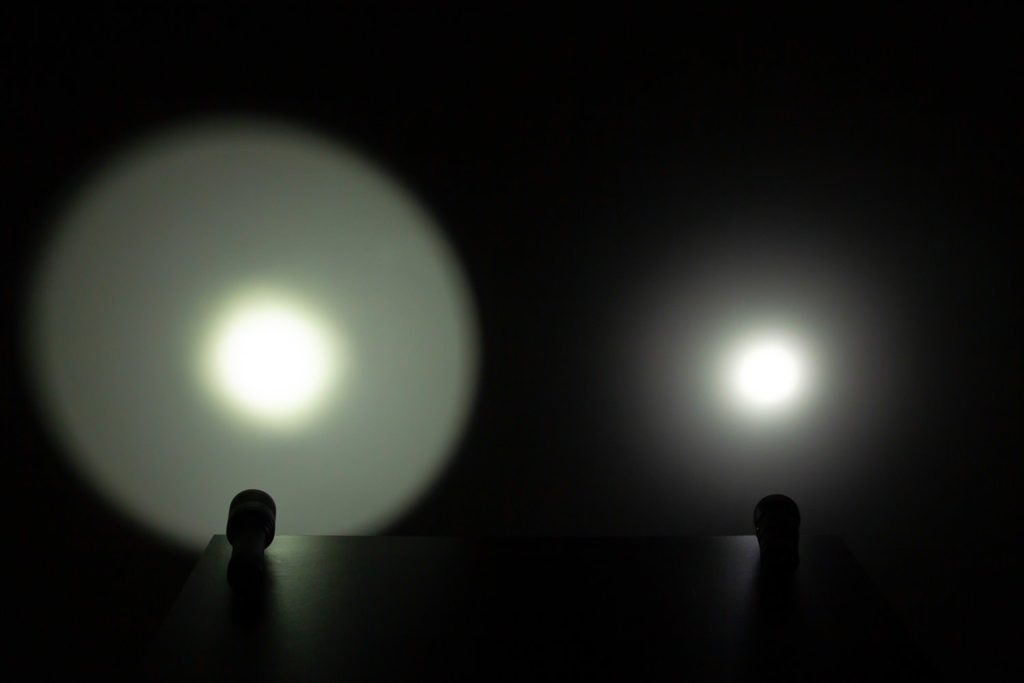
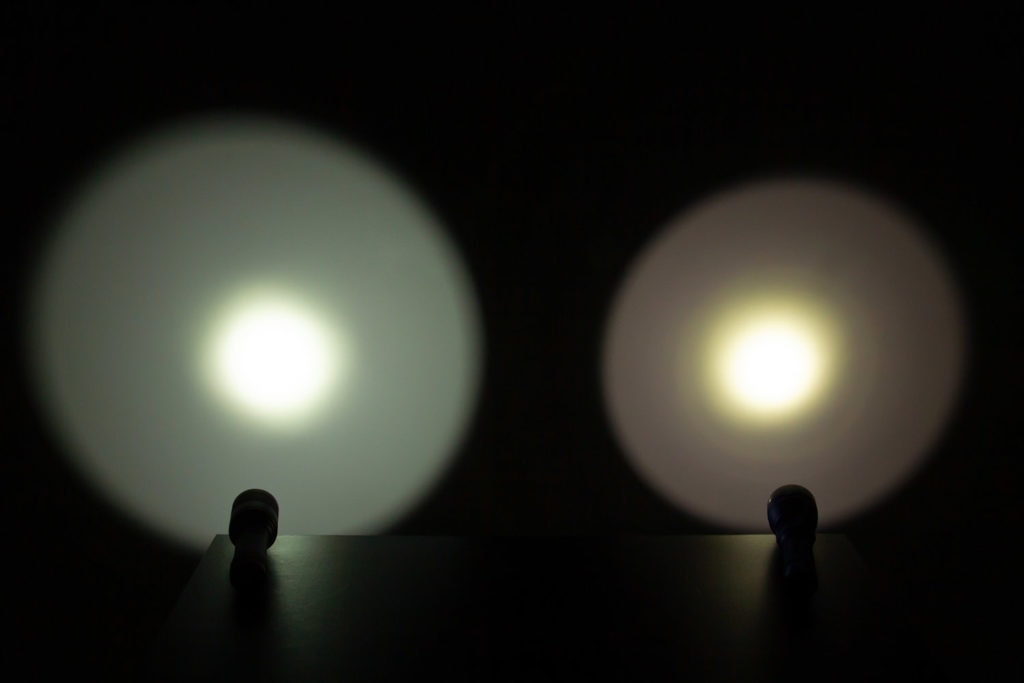
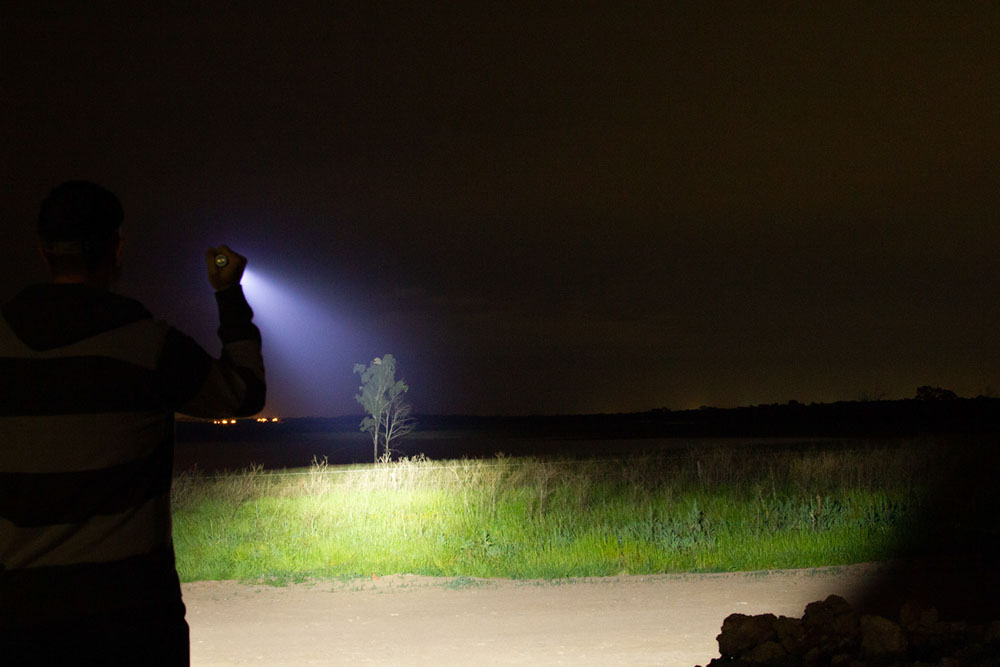
Disclaimer: This flashlight was sent to me for review at no cost, by Nealsgadgets. I have not been paid to review, nor have I been holding back on problems or defects.
OVERALL CONCLUSION
Pros
- Ridiculous output for the size
- FWxx design, very pleasing aesthetic
- Anduril, so you can choose your own output
Cons
- Ramps down very quickly
- Gets hot, fast

5 stars: ★★★★★
Let’s be real – this is a trick pony. An SBT90 in a body this small? The sheer drop in output after 30 seconds on turbo is phenomenal.
But what a trick pony. Ordinarily I’d be annoyed at drop-offs like this, but I just keep laughing every time I blast this out. I know it has its limitations, but I just don’t care. It’s a similar feeling to the first time I turned on my GT90 – I expected something pretty impressive, but I wasn’t quite prepared for it.
Is it an expensive toy? Sure, but it doesn’t pretend to be anything else, and it’ll always put a smile on your face.
I give the Lumintop X9L five stars, and I think I need to stock up on 21700s now.
Lumintop X9L for sale
Use our 15% off coupon: 1lumen711
1lumen selects and reviews products personally. We may earn affiliate commissions through our links, which help support our testing.